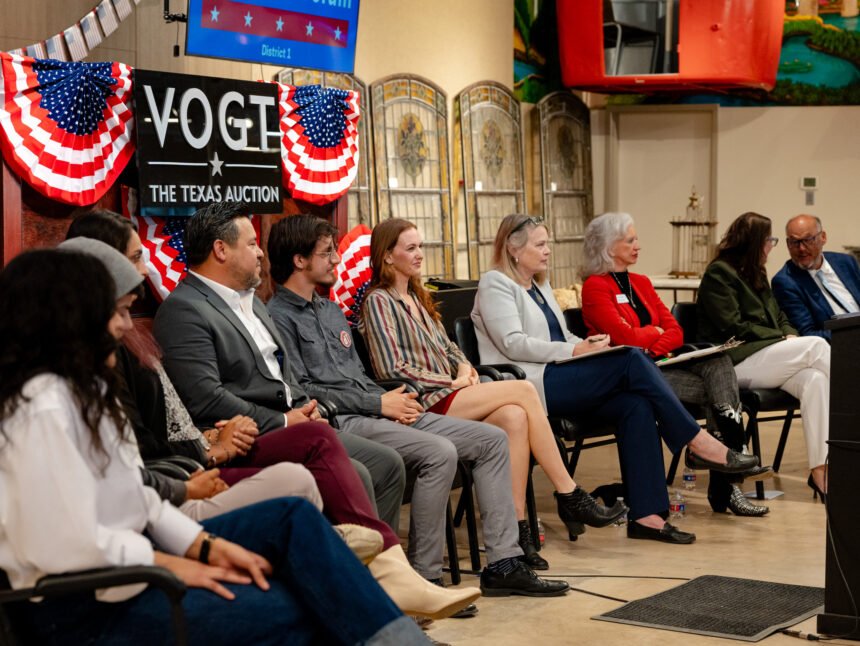A crowded District 1 City Council race has become unusually nasty this year.
First-term Councilwoman Sukh Kaur, 36, is scrambling to defend a somewhat slow start navigating City Hall, while some neighborhood leaders who spent years grooming her predecessor are already working to install someone new.
The 10-way race features two neighborhood association leaders — Susan Strawn, 63, of downtown’s River Road neighborhood, and Patty Gibbons, 65, of the North Side’s Greater Harmony Hills neighborhood — whose respective neighborhood coalitions each held candidate forums rife with complaints about residents feeling blindsided by city development projects and zoning issues.
Gibbons and Strawn are among the top-fundraising challengers.
Adding to an already tense race, a self-funding candidate, bar owner Julisa Medrano-Guerra, 27, launched a District 1 campaign this year after she said Kaur wouldn’t help when her business was suffering from the impacts of nearby construction.
Now Medrano-Guerra is paying political operatives known for their scorched-earth tactics, and after hiring a private investigator to follow Kaur, filed a wide-ranging ethics complaint accusing the councilwoman of hiding assets and misusing city resources.
Most of the allegations have already been dismissed by an attorney the city hired to look into them. But a portion of it, accusing her chief of staff Ryan Salts of conflating campaign work and official council business, will be considered by the city’s Ethics Review Board.
Through it all, Kaur, who owned an education consulting business before running for council, has maintained a large network of supporters who like her apolitical approach and say she’s learned quickly in her first two years.
She’s raised roughly three times as much campaign cash as her best-funded challengers, reporting $110,000 on hand as of March 24, and earlier this year benefitted from ads promoting her work paid for by the nonprofit arm of a business-backed group, Better SA.
Kaur came into the role with very little political experience and had a number of early staff shuffles in her District 1 office. But over time, she’s earned the respect of her council colleagues and taken leadership roles in downtown redevelopment projects like Project Marvel, the new Missions’ Minor League Baseball team and housing along a rapid transit line down San Pedro Avenue.
“We’ve got to make sure we’re moving forward as a city, and we’ve done that,” Kaur said in a recent interview about her first term. “We’ve supported policies that are going to ensure that we have a San Antonio that our kids can thrive in, by creating transit opportunities, by creating more housing opportunities.”
While plenty of District 1 residents are excited about those projects, Kaur said, their voices don’t always get as much airtime as frustrated neighborhood and business leaders — leading to this year’s crowded race.
“I think people really want to get [in there] to see if they can do this job better,” she said.
Last election cycle Kaur was among those eyeing the District 1 seat from the outside, launching a long-shot bid that surprised political watchers when she finished first in a seven-way race. She went on to trounce incumbent Mario Bravo in a runoff, to the frustration of neighborhood leaders who felt Bravo had just finally learned the job after two years in office.
This year the stakes are a little different. Candidates are vying for a four-year term for the first time instead of two — giving critics more motivation to force a change while they have the chance.
Early voting runs April 22 through April 29 for the May 3 election, and if no candidate takes at least 50% of the vote, the top two finishers will advance to a runoff on June 7.
“The race seems to have become more, for lack of a better term, vicious, than how it initially started,” said Elizabeth Eichhorn, president of Beacon Hill Area Neighborhood Association, who has been working closely with Kaur on a number of issues related to her neighborhood, but is staying neutral in the race.
“What that shows to me more than anything is a frustrated district, and the feeling of people not getting their way.”
View from the north

District 1 encompasses most of downtown — the city’s economic engine — but also stretches up to include most of the neighborhoods between I-10 and U.S. 281, and even some territory north of Loop 410.
At the heart of this year’s crowded race is bubbling frustration with a number of recent city projects that all happen to be within the district’s boundaries: From the Migrant Resource Center to VIA Metropolitan Transit’s Green Line, to the new Missions’ Minor League Baseball stadium and now a proposed NBA arena.
Among the large field of challengers are a number of candidates who say their personal experiences in those major city disputes weren’t given thorough consideration, leaving them feeling helpless when making their cases to city leaders.
Gibbons, for example, is a retired land surveyor who rallied hundreds of homeowners against the city’s plans for transit-oriented development — zoning that allows for denser, car-free housing — along San Pedro Avenue’s forthcoming rapid transit line.
Going into this election cycle she had already lost a fight to keep the city from drawing her Northside-Greater Harmony Hills neighborhood into D1 — known as one of the city’s more progressive, downtown council districts — during the 2022 redistricting process.
When transit-oriented development then threatened to bring urbanization across Loop 410, she responded by launching a council campaign in October.
“Nobody was notified in any of these maps, of any of these zoning changes, none of these businesses,” Gibbons said at a candidate forum hosted by the district’s Northside neighborhoods, which have dubbed themselves the North D1 Neighborhood Alliance.
Gibbons has raised $18,000 over the course of five months, loaned her campaign $25,000 and hired an Austin-based consulting firm that worked for conservative state Reps. Mark Dorazio and Marc LaHood.

Historic neighborhoods
Meanwhile, the district’s historic downtown neighborhood leaders, who generally liked Kaur’s predecessor, also have a candidate from their own ranks in the race this year.
Strawn, originally from Houston, moved to San Antonio for her job as a federal prosecutor and fell in love with the city’s historic enclaves.
But after a number of city projects threatened the tranquility of her tree-canopied neighborhood nestled in Brackenridge Park, Strawn said she became motivated to protect the neighborhoods from a City Council that’s eager to make San Antonio’s downtown more like other large cities’.
“I think what makes San Antonio special is the history, the historic neighborhoods, the historic parks that can be so beautiful that they attract young families here, and they attract people who want to have a good lifestyle,” Strawn said in a recent interview. “I don’t think San Antonio wins by pursuing a vision that makes it into another Dallas or another Sun Belt city.”
She credits her fight against a 2017 bond project that sought to take out a number of 100-year-old trees in Brackenridge Park — part of an effort to restore several historic structures — for turning her into an activist. And now that she’s just recently retired, she said, she has time to make that work into a full-time job.
Strawn had raised $12,000 as of March 24 and loaned her campaign $10,000.
“I’m running because I think, like many of you, we believe that the neighborhoods have been ignored in this last administration,” she said to a friendly audience at a recent candidate forum hosted by the district’s downtown neighborhood leaders.

Another candidate, Maureen Galindo, 37, moved back to San Antonio with her three kids in 2017 and settled into one of downtown’s last naturally occurring affordable housing complexes, the Soap Factory apartments.
Those apartments are now slated to be razed to make way for the new Missions’ Minor League Baseball stadium and surrounding apartments, and Galindo, who started a tenants’ union, got involved in city politics by lobbying for a moving stipend for Soap Factory residents.
She’s a family therapist with a master’s degree in community psychology and launched a council campaign because she was alarmed by the city’s lack of concern for how vulnerable residents are impacted by their plans for growth.
“I’ve had to survive on very little before, and it feels offensive to me when I see them just throwing millions, billions of dollars into all of these deals,” said Galindo, who drew plenty of nods at candidate forums for her passionate critiques of city leadership.
The rest of the field
Ramiro Gonzales, 44, is a seasoned City Hall staffer who spent 15 years working in the city manager’s office and has a background in economic development. While he’s made polished pitches at candidate forums, his pro-growth policy perspective hasn’t done much to differentiate him from Kaur.
Among the other candidates running, Anita Marie Kegley, 68, is a home inspector who runs a Church and Politics group and is campaigning to “to put God back in our city.”



Dominique Littwitz, 27, is an entrepreneur who sells pizza-sized quesadillas at festivals and events. Matthew Gauna is an environmental science student. Arnulfo Ortiz, 67, is a curmudgeonly attorney who raised eyebrows calling for the city to ship its homeless population to El Salvador at the North D1 Neighborhood Alliance forum.
Perhaps the most perplexing candidate, however, is Medrano-Guerra, a political newcomer running on her experience as a bar and restaurant owner hurt by ongoing city construction.
“I watched it firsthand as the sales drastically started dropping,” said Medrano-Guerra, who added that she was denied a city-funded construction mitigation grant because her businesses weren’t close enough to the nearby Broadway construction. “A few other businesses around here had to close, and we were trying to stay afloat.”
Around the same time, her establishment, the Paramour Bar, was embroiled in a legal battle with its landlord, and staff was temporarily locked out of the building after the landlord alleged that the bar’s owner failed to pay rent.
Medrano-Guerra started working at the bar in 2023, but her campaign says she’s not responsible for that part of the bar’s track record because she only became an owner in August of 2024. That’s shortly after she married her husband, attorney Martin Phipps — who recently won one of the city’s only successful ethics review complaints against another council member — and Phipps transferred half the bar’s ownership to her name.
“Martin’s brilliant, but he’s terrible with money,” Medrano-Guerra said in a March 1 interview, adding that she’s since taken over managing the bar’s finances.
Bar drama aside, Medrano-Guerra had raised just $75 as of March 24, but put $36,000 of her own money into the race — making her the second-highest spender, behind Gibbons, on the most recent reports.
About $15,000 went to a consulting company owned by Colin Strother — a longtime aide to U.S. Rep. Henry Cuellar (D-Laredo) and the mastermind behind Cuellar’s aggressively negative primary campaigns. Strother recently pleaded guilty in Cuellar’s bribery case and is awaiting sentencing. Another $6,000 went to Potomac Strategy Group, owned by former Travis County Republican Party Chair Matt Mackowiak.
In a nod to the increasingly nasty tenor of the race, the campaign sent out mailers showing Kaur’s face on a milk carton, saying she “vanished” after the 2023 runoff, “along with her promises to listen.”

Asked about the campaign staff choices, Legrand said Strother is a personal friend of Phipps.
“Martin has believed in me and he’s always been the one that’s like, ‘Hey, you could do so much more,’” Medrano-Guerra said of her decision to enter politics. “I really hadn’t ever thought about it until I reached out to [Kaur], thinking that she would be the person that I could come to as our business was struggling, and then she was a little rude.”
Kaur’s first term
Kaur, for her part, says the fragmented race is evidence of the challenging job.
District 1 has some of everything, from historic neighborhoods to some of the city’s most underserved communities, often within a stone’s throw of one another, she said in a recent interview.
“It’s unique, and you see that in the candidates. There are people coming from all different vantage points,” she said. “Some of them are running for a specific issue that they felt like they want to focus on. But in this district, you can’t just be one-issue focused. You have to think about the district at large.”
At a recent candidate forum hosted by the downtown districts, Kaur took the opportunity to showcase some of that experience, correcting another candidate’s characterization of how infrastructure projects are prioritized.
Before serving on the council, she said, she believed it worked the way other candidates had suggested, with politics dictating what gets fixed first. Since then, she’s learned that work needs to be done assessing how quickly streets are degrading based on their use — something she said she’s hoping to work on in a second term.
At her reelection launch on Feb. 22, roughly 200 supporters packed into the Cove seemed ready and eager to give her that chance.
Though it took some time to learn the ropes and build out a council office, Kaur told the crowd, in recent months she’s been able to champion plans to reshape at how the city approaches construction projects and bring more stakeholders to the table on how to approach transit-oriented development.
“She’s willing to be up there on the dais and have really high level conversations about things that matter to our city,” said Christina Martinez, president of the San Antonio ISD school board, who spoke at the campaign launch. “Every time I listen to her up there I’m just mesmerized because she’s asking a tough question. She’s looking at the data. She knows her stuff.”













